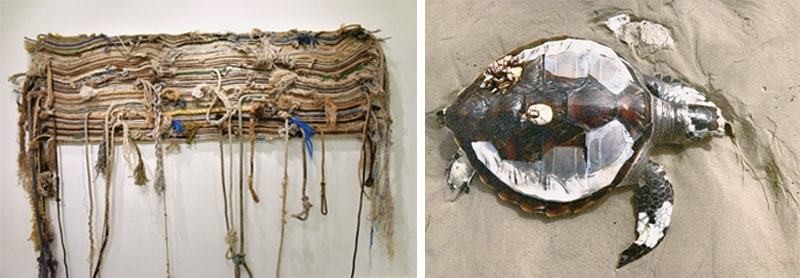
Sohail Zuberi collected objects from the beach for seven years to give us a glimpse into the life of the sea

Archaeologies of Tomorrow is a solo show by Karachi-based graphic designer, photographer and visual artist Sohail Zuberi who has been associated with academia for the past sixteen years. This show is a result of his solitary walks and finds from a two-kilometer stretch of the Clifton beach in Karachi - just off the often crowded strip of the beach that is across hundreds of apartment blocks. The show opened at Koel Gallery (May 8 – May 17), well-curated by Zarmeene Shah.
Walking for most people is a habituated action that requires very little thought or concentration, although it is also a great meditative technique. But fewer walk with the purpose of exploration, or to explore the relationship between walking and thinking, walking and nature, walking and culture. There is likely to be an abundance of colours, shapes, textures and objects all around but it requires an ‘archaeologist’ such as Zuberi to painstakingly photograph, document, clean and preen, mount and write their narratives, giving them a new lease of life.
I am moved by Zuberi’s ‘archaeologies’, which I find philosophically engaging as a confluence of art and science - a field research on issues surrounding dislocation, economy and environmentalism; an elucidation of ideas and experiences, of beliefs and practices that he has displayed so aesthetically. For the last seven years he has taken these walks on the beach, collecting ‘artifacts’ which constitute an instrument for reclaiming the world of the fisher folk who spend their entire lives on and around the sea. In doing so Zuberi gives an insight into the ‘modern-day archaeological relics’ but also to show what a terribly hard life they lead.
Karachi dumps millions of gallons of waste into its harbours every day, which has made it impossible to catch any marine life closer to the shores. Fishermen therefore have to go further and deeper into the ocean and also suffer periodic arrest and long sentences. During my own research for a book about this community almost a decade ago, I had learnt that on the Arabian Sea coastline shared between Pakistan and India there is no proper demarcation of the sea border because of the Sir Creek issue. The agencies patrolling these waters have worked out an imaginary line along the Sir Creek region off the coast of Kutch. Unknowingly fishermen encroach into each other’s territory because of tidal currents or engine failures and are caught by the Coastguards, leading to long confinements in jails. The families of the arrested fishermen then confront terrible conditions, facing starvation.
It is no surprise then that some part of what washes up onto the beaches is constituted of items that have religious significance such as taaweez (talismans). It is believed that these will protect the fishermen from getting caught not only the vagaries of the sea but also by the coastguards. Some of the religious items found by Zuberi are displayed as photographs - of holy texts returned by the sands of time, and prayer caps of all sizes, shapes and materials, while the rest of the paraphernalia such as wooden rehels of all sizes (X-shaped foldable book rest used for placing holy books) are displayed in the gallery.
The fishing sector provides occupation to almost one million people, and the boat is everything to the fishermen. More than 15,000 fishing vessels of various sizes, ranging from small to medium-sized boats, large launches, and trawlers, engage in fishing. However, fragments from sunken boats that capsize wash up onto Karachi’s beaches. Zuberi has found planks of wood - from Teakwood to Keekar with decorative motifs painted on them. He has also got an enormous collection of basic kitchen tools and utensils made in wood. Many of us who go ‘crabbing’ in Karachi are familiar with the boatmen preparing delicious meals on the boat from their own haul of crabs, shrimps and fish using these simple objects for grinding spices, etc.
My favourite piece, among several others, is a tapestry of found ropes that the artist has woven together. He assures that their lengths are not altered nor has he untangled any of their knots. "In fact, one can decipher their purpose by just studying different types of fishermen’s knots," he says. The noose like ending of the ropes is used for docking the boat at the pier. The rope therefore becomes a physical and symbolic lifeline. Another eye-catching piece is a totem-pole of stones. It comes as a complete surprise that the ‘stones’ are actually pieces of foam that wash up on to the beach and get buried in sand, taking on the colour and appearance of stones.
Relocation is part of the nature of beaches. Zuberi’s found objects imply the many dimensions of increasingly pressing social and ecological
problems that are a part of this relocation.